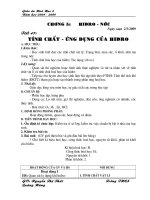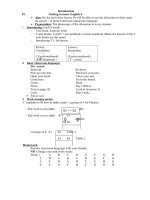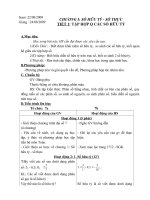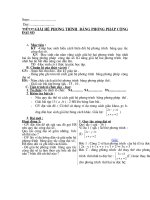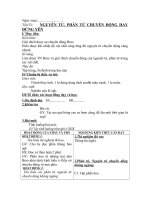giao an anh 7 tu tiet 34 den 40
Bạn đang xem bản rút gọn của tài liệu. Xem và tải ngay bản đầy đủ của tài liệu tại đây (170.85 KB, 13 trang )
<span class='text_page_counter'>(1)</span><div class='page_container' data-page=1>
Ngày soạn:
<b>Ngày dạy:</b>
P34. Unit 6 After school – A2
A- The aims and requests:
<i>1. The aims:</i>
<b>-</b> Help ss develop speaking skill.
<b>-</b> By the end of the lesson the ss will be able to practice in
adverbs of frequecy with the simple present tense for after
school activities.
<i>2. Teaching points:</i>
<b>-</b> Futher practice in adverbs of frequency.
<i>3. Preparation:</i>
<b>-</b> pictures, textbook, extra-board, chalks.
B- Procedures:
Teacher’s activities T Students’ activities
<i><b>I.Organization:</b></i>
-Good afternoon, class!
-How are you today?
-Who is absent today?
<i><b>II.Checking up:</b></i>
*S1: read A1 and answer my questions:
<i>a)What is Hoa doing?</i>
<i>b)Is tomorrow Sunday?</i>
<i>c)What should Hoa and Minh do tomorrow?</i>
*S2: write vocabulary.
Warm up:
- divide the whole class in to two teams, in 1
minute each team has to write adverbs of frequecy
they have learnt. The team writes correct and quick
words is the winner.
<i><b>III.New lesson:</b></i>
<b>1-Revision: </b>
Labelling A2p61.
-T asks ss to look at the activities in the pictures and
label the pictures:
Answer key:
<i>1-reading</i>
<i>2-swimming</i>
<i>3-playing video games</i>
<i>4-going to the movies</i>
<i>5-playing soccer</i>
<i>6-watch TV</i>
<b>2-Practice:</b>
Noughts and crosses:
- Ask ss to repeat the form of asking about the
things someone plays at recess.
<i>always go </i>
<i>swimming</i> <i>often go to the beach</i> <i>often go to the library</i>
<i>usually play </i> <i>sometimes play </i> <i>never go to the </i>
2’
7’
5’
16’
- ss greet.
- answer
-read and answer the
questions
-write vocab
-2 teams write
-look at pictures and
label them.
-ss do Ns and Crs
+one asks
</div>
<span class='text_page_counter'>(2)</span><div class='page_container' data-page=2>
<i>soccer</i> <i>video games</i> <i>movies</i>
<i>usually watch </i>
<i>TV</i> <i>often play tennis</i> <i>sometimes do homework</i>
*Example exchange:
<i>S1: What do you usually do after school?</i>
<i>S2: I usually watch TV.</i>
<b>3-Further practice:</b>
*Language focus 2: Ex5P71:
- Teacher asks ss to read activities and
match with suitable adverbs of frequency,
then write sentences using the table about
Ba.
<b>E.g: Ba never goes to the cafeteria at lunch time.</b>
<i><b>IV.Consolidation</b>:<b> </b></i>
- ss say some adverbs of frequency.
<i><b>V.Homework:</b></i>
- do exercises A1 + A2 (P33) + A5 (P41).
- Prepare A3,4P62-63.
10’
3’
2’
-read and match, then
write
-say adverbs of
frequency
-copy
Ngày soạn:
<b>Ngày dạy:</b>
P35. Unit 6 After school A3,4
A-The aims and requests:
<i>1. The aims:</i>
<b>-</b> Help ss develop listening and reading skills.
<b>-</b> By the end of the lesson the ss will be able to practice the school
activities vocabulary by listening and reading the text for
details.
<i>2. Teaching points:</i>
<b>-</b> Futher practice in reading some other activities after school
hours..
<i>3. Preparation:</i>
<b>-</b> stereo, tape, pictures, textbook, extra-board, chalks.
B-Procedures:
Teacher’s activities T Students’ activities
<i><b>I.Organization:</b></i>
</div>
<span class='text_page_counter'>(3)</span><div class='page_container' data-page=3>
-How are you today?
-Who is absent today?
<i><b>II.Checking up:</b></i>
<b>-</b> 2 ss write adverbs of frequency.
<i><b>III.New lesson</b><b> </b>:</i>
<b>1- Revision:</b>
*Listening A4P63:
-T asks ss to listen to the stereo twice and match each name
to an activities.
Answer key:
<i>-Mai: go to the school cafeteria.</i>
<i>-Nam: rehearse a play.</i>
<i>-Ba: go to the circus.</i>
<i>-Lan: watch movies.</i>
<i>-Kien: tidy the room.</i>
<b>2- Pre reading:</b>
Vocabulary:
<i>*rehearse(v): diễn tập (thờng dùng với các vở kịch)</i>
<i>*(an) hour: gi (ng h)</i>
<i>* pastime(n): trò tiêu khiển</i>
<i>* member(n): thành viên</i>
<i>*school theater group: nhóm kịch ở trờng</i>
<i>*(a) play: vở kịch</i>
<i>*school anniversary celebration:lƠ kû niƯm thµnh lËp trêng</i>
<i>*president(n): chđ nhiƯm (nghÜa trong bài), chủ tịch</i>
<i>*stamp collector s club(n): CLB nhng ng</i> <i>ời su tập tem</i>
<i>*together(adv): cùng với, đồng thời</i>
<i>*bring(v): mang l¹i, ®em l¹i</i>
<i>* sporty(adj): thÝch thĨ thao</i>‘
<i>*comics(n): trun tranh</i>
<i>*lie(v): n»m</i>
<i>* circus(n): gánh xiếc l</i>‘ <i>u động</i>
<i>*tidy(adj):gọn gàng, ngăn nắp</i>
<i> (v):dọn dẹp, làm gọn gàng</i>
Open prediction:
<i>ở tiết trớc các em đã đợc học các từ miêu tả hoạt động </i>
<i>ngoài giờ học, bây gời các em hãy nhìn vào 3 bức tranh </i>
<i>trang 62 và đoán xem những bạn trong tranh đang làm gì?</i>
<b>3- While reading:</b>
-ask ss to read A3 and check their predictions; compare with
their friends and answer the questions.
Answer key:
<i>a)Her group is rehearsing a play for the school anniversary</i>
<i>celebration.</i>
<i>b)He gets American stamps from Liz, his American friend.</i>
<i>c)The stamp collector s club meets on Wednesday </i>’
<i>afternoon.</i>
<i>d)Nam never play games.</i>
<b>4- Post reading:</b>
Write it up:
-ask ss to use A4 to write a short paragraph about after
5’
5’
10’
13’
-write
-listen and match
-listen
-answer
-repeat
-say meaning
-copy
-predict
</div>
<span class='text_page_counter'>(4)</span><div class='page_container' data-page=4>
school activities.
<b>E.g: After school hours, Mai often goes tothe school </b>
<i>cafeteria...</i>
<i><b> IV.Consolidation</b>:<b> </b></i>
- ss say some activities after school.
<i><b>V.Homework</b><b> </b>:</i>
- Learn cabulary by heart + read A3 again.
- Prepare B1P64.
5
3
2
-write
-say
-copy
Ngày soạn:
<b>Ngày dạy:</b>
P36. Unit 6 After school – B1
A-The aims and requests:
<i>1.The aims:</i>
<b>-</b> Help ss develop listening and reading skills.
<b>-</b> By the end of the lesson the ss will be able to understand and
make suggestions with “Let’s + V...; What about + V_ing...?;
Why don’t you + V...?” and ss also revise some modal verbs
such as: CAN, SHOULD....
<i>2. Teaching points:</i>
<b>-</b> suggestions with “Let’s + V...; What about + V_ing...?; Why
don’t you + V...?” and some modal verbs such as: CAN,
SHOULD....
<i>3.Preparation:</i>
<b>-</b> stereo, tape, pictures, textbook, extra-board, chalks.
B-Procedures:
Teacher’s activities T Students’ activities
<i><b>I.Organization:</b></i>
-Good afternoon, class!
-How are you today?
-Who is absent today?
<i><b>II.Checking up:</b></i>
<b>-</b> 2 ss write vocab.
<b>-</b> S3 reads A3 and answers my
questions:
a)What is Nga’s favorite pastime?
b)Who is the president of the stamp collector’s club?
c)What does Nam usually do in the afternoon?
<i><b>III.New lesson:</b></i>
<b>1 -Presentation:</b>
Preteach:
<i>*(a) assignment: bµi tËp vỊ nhµ</i>
Presentation text:
-T introduces: In the last period, you studied about
<i>after school activities. And now we continue </i>
<i>listening to and talking about these activities.</i>
2’
7’
14’
-ss greet and answer
-2ss write
-S3 reads and answers the
teacher’s questions.
-listen and copy
</div>
<span class='text_page_counter'>(5)</span><div class='page_container' data-page=5>
-T elicits the dialogue and asks ss to guess “What
they are going to do tonight?”
-Let ss read the text.
-T introduces structures:
<b>*E.g</b>
<i>+Let s go to my house.</i>’
<i>+What about going to the movies?</i>
<i>+Why don t you relax?</i>’
*Cách đề nghị, hay gợi ý ai làm một việc nào đó:
<i>Let s + V....</i>’
<i>What about + V_ing...?</i>
<i>Why don t you + V....?</i>’
-Khi đồng ý hay nhận lời ta dùng:
+ Great. hc Oh, I d love to.’ hc Good idea.
-Tõ chèi:
+I am sorry + lý do tõ chèi...
Comprehension questions:
<i>a) Nam wants to go to the movies.</i>
<i>b) Lan doesn t want to go to the movies because </i>’
<i>there aren t any good movies at the moment.</i>’
<i>c) Lan wants to listen to some music at her </i>
<i>house.</i>
<i>d) Hoa doesn t want to go to Lan s house </i>’ ’
<i>because she has so many assignments.</i>
e) <i>It s Saturday.</i>’
<b>2-Practice:</b>
Word cue drill:
<i>-</i> <i>Let s/listen/music (Yes)</i>’
<i>-</i> <i>What/watch/movie?(No/have to tidy </i>
<i>our house)</i>
<i>-</i> <i>What/go/cafeteria?(No/ do homework)</i>
<i>-</i> <i>Why/play/ soccer?(Yes)</i>
*Example exchange:
<i>S1: Let s listen to some music.</i>’
<i>S2: Yes, let s./Good idea.</i>’
3-Further practice:
Mapped dialogue:
<i>You</i> <i>Your friend</i>
<i>-What ... do this </i>
<i>afternoon?</i>
<i>-....not good movie.</i>
<i>-too far ... not have a </i>
<i>bike.</i>
<i>OK.</i>
<i>-...movies</i>
<i>-...Mai s house.</i>’
<i>-...take a bus.</i>
<i>S1: What should we do this afternoon?</i>
<i>S2: Let s go to the movies.</i>’
<i>S1: There isn t any good movies on.</i>’
<i>S2: What about going to Mai s house?</i>’
<i>S1: But it s too far. I don t have a bike.</i>’ ’
<i>S2: Why don t we take a bus?</i>’
<i>S1: OK.</i>
5’
10’
4’
-read and check
-answer and give
examples
-copy
-read and answer the
questions
-practice whole class,
half and half, open pairs
and closed pairs
</div>
<span class='text_page_counter'>(6)</span><div class='page_container' data-page=6>
<i><b>IV.Consolidation:</b></i>
<b>-</b> Revise the structures of
suggestions.
<i><b>V.Homework:</b></i>
<b>-</b> Read B1 again and translate it
into Vietnamese.
<b>-</b> Prepare B2
<b>-</b> Learn uses and structures by
heart.
2
1
-revise and say some
suggestions
-copy
Ngày soạn:
<b>Ngày dạy:</b>
P37. Unit 6 After school – B2
A-The aims and requests:
<i>1.The aims:</i>
<b>-</b> Help ss develop reading skill.
<b>-</b> By the end of the lesson the ss will be able to understand
activities of American teenagers by reading the text.
<i>2. Teaching points:</i>
<b>-</b> The most popular activities of American teenagers and getting
further practice in leisure vocabulary.
<i>3.Preparation:</i>
<b>-</b> stereo, tape, pictures, textbook, extra-board, chalks.
B-Procedures:
Teacher’s activities T Students’ activities
<i><b>I.Organization:</b></i>
-Good afternoon, class!
-How are you today?
-Who is absent today?
<i><b>II.Checking up:</b></i>
<b>-</b> 2 ss write vocab.
<b>-</b> S3 reads B1 and translate it into
Vietnamese:
<b>-</b> S4: write the structures of
suggestions and give the examples.
<i><b>III.New lesson:</b></i>
<b>1-Pre reading:</b>
Preteach:
<i>*a magazine survey:cuộc khảo sát của mét t¹p chÝ</i>
<i>*show(v):cho biÕt</i>
<i>*teenager(n): thiếu niên (từ 13 đến 19 tuổi)</i>
2’
7’
8’
-ss greet and answer
-2ss write
-S3 reads and
translate it into
Vietnamese.
-S4:write the
structures of
suggestions and
give the examples
-listen
-answer
-repeat
</div>
<span class='text_page_counter'>(7)</span><div class='page_container' data-page=7>
<i>*top ten(n):mời hạng đầu</i>
<i>*fast(adj): nhanh</i>
<i>*attend(v):tham dự</i>
<i>*scout = boy scout(n):nam hớng đạo sinh(tổ chức này </i>
nhằm rèn luyện cho hội viên những kỹ năng thực tiễn và
xây dựng nhân cách)
<i>*guide = girl guide(BE) = girl scout(AE):nữ hớng đạo </i>
<i>sinh</i>
<i>*musical instrument(n):dụng cụ âm nhạc</i>
<i>*coins(n): tiền xu</i>
<i>*model(n): mẫu, mô hình </i>
- Vocab checking: Rub out and remember:
Open prediction:
-Teacher asks ss to predict what American teenagers like
to do in their free time.
<b>2-While reading:</b>
-T asks ss to read B2P65 and check their prediction.
Comprehension questions:
1-Which of the activities in the list of American teenagers
do you think are also popular among Vietnamese
teenagers?
<i>-</i> <i>Watch TV, listen to music, go to the movies </i>
<i>help old people.</i>
2-Are there many kinds of entertainment for teenagers in
Vietnam? What are they?
3-What organizations are there for teenagers in Vietnam?
- <i>Những tổ chức nh Đội thiếu niên tiền phong </i>
<i>và các hình thức câu lạc bộ khác dành cho </i>
<i>thiếu niên.</i>
<b>3-Post reading:</b>
*Discussion:
- T asks ss to discuss what they like doing in their free
time, make a list of their group’s favorite leisure activities.
<i><b>IV.Consolidation:</b></i>
<i>- Revise the groups, or organization of teenager in </i>
<i>Vietnam. Make the difference between American & </i>
<i>Vietnamese activities.</i>
<i><b>V.Homework:</b></i>
-Learn vocab by heart.
-Read B2 & translate it into Vietnamese.
-Prepare B3,4
3’
15’
6’
3’
1’
-do R & R
-predict
-read & check
-answer the
questions.
-discuss in group
-answer
-copy
Ngày soạn:
<b>Ngày dạy:</b>
P38. Unit 6 After school – B3,4
</div>
<span class='text_page_counter'>(8)</span><div class='page_container' data-page=8>
<b>-</b> Help ss develop listening and reading skills.
<b>-</b> By the end of the lesson the ss will be able to understand and
practice the invitations and polite refusal/acceptance of
invitations through reading the text.
<i>2. Teaching points:</i>
<b>-</b> Modal: polite refusal/acceptance of invitations.
<i>3.Preparation:</i>
<b>-</b> stereo, tape, textbook, extra-board, chalks.
B-Procedures:
Teacher’s activities T Students’ activities
<i><b>I.Organization:</b></i>
-Good afternoon, class!
-How are you today?
-Who is absent today?
<i><b>II.Checking up:</b></i>
<b>-</b> 2 ss write vocab.
<b>-</b> S3 reads B2 and translate it into
Vietnamese:
<i><b>III.New lesson:</b></i>
<b>1-Pre teach:</b>
-T dẫn dắt: <i><b>Trong đời sống giao tiếp hàng ngày </b></i>
<i><b>chúng ta thờng xuyên phải dùng lời mời. Trong tiết</b></i>
<i><b>học này chúng ta sẽ đợc học cách mời, từ chối và </b></i>
<i><b>nhận lời mời một cách lịch sự và tế nhị nhất.</b></i>
a)Vocabulary:
<i>*pleasure(n): niềm vui thích, sự thích thú</i>
<i>*a wedding: đám cới</i>
<i>*That s too bad = What a pity: TiÕc qu¸!</i>’
<i>*Thanks anyway(expression):dù sao cũng cảm ơn.</i>
<i>*community service:hoạt động giúp cộng đồng</i>
<i>*elderly people: ngời già/cao tui</i>
<i>*clean(v): làm sạch</i>
<i>*even(adv): ngay cả, thậm chí</i>
<i>*paint(v): sơn, vẽ</i>
<i>*(to) <b>help</b> someone <b>with</b> something:</i>
<i>*volunteer(n): tình nguyện viên</i>
<i>*(to) be concerned <b>about</b>....quan tâm, lo lắng</i>
<i>* candy stripers : hộ lý tình nguyện</i>
<i>*neighborhood clean-up campaigns:các chiến dịch </i>
<i>làm sạch khu dân c</i>
b)Presentation dialogue:
Mai: Tomorrow will be my fourteenth birthday. I am
<i>going to have a birthday party at 5pm. </i>
<i>Would... to come to my birthday?</i>
Hoa: Yes, ...
<b>- C¸ch mêi:</b>
(?) Would you like to + V/N...? (=>cách mời thông
dụng và dùng rộng r·i nhÊt)
2’
8’
2’
7’
7’
-ss greet and answer
-2ss write
-S3 reads and
translates it into
Vietnamese.
-listen
-answer
-repeat
-say meaning
-copy
</div>
<span class='text_page_counter'>(9)</span><div class='page_container' data-page=9>
*Mét sè cÊu tróc th©n mËt h¬n:
<i> + Why don t you + V...?</i>’
<i> + What/How about + V_ing ...?</i>
<b>-</b> <b>NhËn lêi mêi: </b>
<i> + Yes, I d love to.</i>’
<i> + That would be great fun.</i>
<i> + OK.</i>
<b>-</b> <b>Tõ chèi lêi mêi:</b>
<i> + I d love to but I am sory I can t.</i>
<b>-</b> <b>Đáp lại lời cảm ơn:</b>
<i> + You are welcome.</i>
<i> + It is my pleasure.</i>
-T turns on the stereo twice
-T asks ss to listen then read the dialogue in pairs.
-T calls some pairs to read aloud
<b>2-Pre reading:</b>
-T elicits:Do you usually do volunteer works? What
<i>are they?</i>
<i>*Do you know what kinds of volunteer works do </i>
<i>American children often do to help community?</i>
-T introduces: Trong tiết học này chúng ta sẽ đợc biết
<i>các bạn thiếu niên Mỹ thờng làm những gì để giúp đỡ</i>
<i>cộng đồng.</i>
<b>3-While reading:</b>
-T asks ss to read the text and list all the activities
that American students do to help community.
<b>4-Post reading:</b>
<i><b>Class discussion:</b></i>
-T asks ss to work in pairs to answer the questions a)
and b) in textbook, then call some pairs to read their
answers.
<i><b>IV.Consolidation:</b></i>
<b>-</b> revise some invitations and
polite refusal/acceptance of
invitations
<i><b>V.Homework:</b></i>
<b>-</b> Learn vocab and forms by heart
<b>-</b> Read B3 again.
4’
3’
6’
3’
2’
1’
-answer and copy
-listen and read
-answer
-listen
-read and list
-work in pairs and
answer the questions
-answer
-copy
Ngày soạn:
<b>Ngày dạy:</b>
P39. Unit 6 Language focus
A-The aims and requests:
<i>1.The aims:</i>
</div>
<span class='text_page_counter'>(10)</span><div class='page_container' data-page=10>
<b>-</b> By the end of the lesson the ss will be able to further practice all
the main structures they have learnt and they have chances to
practice again by doing exercises.
<i>2. Teaching points:</i>
<b>-</b> Modal: polite refusal/acceptance of invitations.
<b>-</b> Present progressive tense, time, vocabulary of subjects
<i>3.Preparation:</i>
<b>-</b> textbook, extra-board, chalks.
B-Procedures:
Teacher’s activities T Students’ activities
<i><b>I.Organization:</b></i>
-Good afternoon, class!
-How are you today?
-Who is absent today?
<i><b>II.Checking up:</b></i>
<b>-</b> 2 ss write vocab.
<b>-</b> S3 reads B3 and answer the
questions:
<i>a)When is Nga s birthday?</i>’
<i>b)When will Nga see Lan?</i>
<i>c)When will Lan call Nga?</i>
- S4: write some structures of invitations and give
examples.
<i><b>III.New lesson:</b></i>
<b>1-Present progressive tense:</b>
<i>(+) S + am/is/are + V_ing ...</i>
<i>(-) S + am/is/are + not + V_ing...</i>
<i>(?) Am/Is/Are + S + V_ing...</i>
<i>- Yes, S + am/is/are.</i>
<i>- No, S + am/is/are + not.</i>
=> T asks ss to do Ex 1P68.
<i><b>* Answer key:</b></i>
Doing – is writing – is reading – is cooking – are
playing – is kicking – running
2-Đại từ chỉ định (this/that/these/those):
ChØ/Sè Sè Ýt Sè nhiÒu
ChØ gÇn This These
ChØ xa That Those
b)this – That – this
c) those – These – those
d) those – these
<b>3-C¸ch nãi giê:</b>
a- Giờ đúng: It is + số giờ + o’clock.
b- Giờ hơn: It is + số giờ + số phút.
<i>hoặc It is + số phút + past + số giờ.</i>
c- Giờ kém: It is + số giờ + số phút.
<i>hoặc It is + số phút + to + số giờ kế.</i>
<b>4-Môn học = Subjects:</b>
*Physical education: m«n thĨ dơc
2’
7’
7’
5’
6’
-ss greet and answer
-2ss write
-S3 reads and answer the
questions:
-write
-answer and write forms.
-do Ex1
-answer and copy
-do Ex 2
</div>
<span class='text_page_counter'>(11)</span><div class='page_container' data-page=11>
*Geography: môn địa lý
*Chemistry: môn hố học
*History: mơn Lịch sử
*Math: Mơn tốn
*English: M«n tiÕng Anh
*Music: Môn âm nhạc
*Biology: Môn sinh học
*Physics: Môn vật lý
*Civic Education: giáo dục công dân
*Fine Arts: Mỹ thuật
*Technology: Kỹ thuật
*Elective Subjects: các môn học tự chọn
*Computer Science: Môn tin học
*Electronics: Môn ®iƯn d©n dơng
<b>5-Trạng từ chỉ mức độ th ờng xun(adverbs of </b>
<b>frequency):</b>
Always, usually, often, somtimes, rarely/seldom,
never luôn đứnảutớc động từ thờng và đứng sau động
từ TO BE.
E.g:
* Hoa never plays soccer.
* She is always a good student in our class.
<b>6-Making suggestions (lời gợi ý, lời mời):</b>
<b>- Cách mời:</b>
(?) Would you like to + V/N...? (=>cách mời thông
dụng và dùng rộng rÃi nhất)
*Một số cấu trúc thân mËt h¬n:
<i> + Why don t you + V...?</i>’
<i> + What/How about + V_ing ...?</i>
<b>-</b> <b>NhËn lêi mêi: </b>
<i> + Yes, I d love to.</i>’
<i> + That would be great fun.</i>
<i> + OK.</i>
<b>-</b> <b>Tõ chèi lêi mêi:</b>
<i> + I d love to but I am sory I can t.</i>
<b>-</b> <b>Đáp lại lời cảm ơn:</b>
<i> + You are welcome.</i>
<i> + It is my pleasure.</i>
<i><b>IV.Consolidation:</b></i>
<b>-</b> revise some structures, invitations
and polite refusal/acceptance of
invitations.
<i><b>V.Homework:</b></i>
<b>-</b> Learn structures and forms by
heart
<b>-</b> Prepare a forty-five minute test
No 2 term I.
5’
5’
6’
1’
1’
-write subjects they have
learnt on bb.
-copy
-do Ex 4
-answer and copy
-give examples
-write sentences about
Ba in Ex 5.
-say some suggestions
and invitations
-give examples
-write down dialogues.
-copy
-answer
</div>
<span class='text_page_counter'>(12)</span><div class='page_container' data-page=12>
Ngµy soạn:
<b>Ngày dạy:</b>
P40. Kiểm tra 1 tiết số 2 học kú I
<b>1. Mơc tiªu:</b>
<b>-</b> Học sinh cần đạt đợc:
+Đọc hiểu: đọc hiểu đoạn văn nói về thơng tin cá nhân của bạn Mai.
+ Viết: Viết một đoạn văn ngắn có hớng dẫn về bạn Hùng.
+ Kiến thức ngôn ngữ: Chọn đáp án thích hợp, sắp xếp thành câu có nghĩa, chia động từ
trong ngoặc cho thích hợp.
2.Ma trËn:
Chủ đề Nhận biết Thông hiểu Vận dụng Tổng
KQ TL KQ TL KQ TL
I-Language focus: 4 4 4 12
<b>2</b> <b>2</b> <b>1</b> <b>5</b>
II- Reading: 5 5
<b>2,5</b> <b>2,5</b>
III- Writing: 5 5
<b>2,5</b> <b>2,5</b>
Tæng 4 4 9 5 22
<b>2</b> <b>2</b> <b>3,5</b> <b>2,5</b> <b>10</b>
<i>Chữ số phía trên bên trái trong mỗi ô là số lợng câu hỏi, chữ số ở góc phải phía dới là tổng </i>
<i>điểm cho các câu ở ơ đó.</i>
<b>3. Néi dung:</b>
§Ị kiĨm tra một tiết số 2 học kỳ I môn Anh 7
<b>Phần A. Language focus:</b>
I.Chọn một đáp án thích hợp trong số A, B, C, hay D để hoàn thành các câu sau,
khoanh tròn đáp án chọn (2 điểm) :
1-What... easy question!
A. an B. some C. a D. any
2-She is ... rope with her friends at the moment.
A. doing B. playing C. skipping D. skip
3- ...does the school library open ?- At 7.30 a.m.
A. How long B. What subject C. Which class D. What time
4-... is it from Cao Thuong to Bac Giang?
- It is about 5 kilometers.
A. How long B. How far C. How often D. How
II-Chia động từ trong ngoặc cho thích hợp (2 điểm):
1-They (see) a movie tomorrow. 1...
2-Binh (listen) to music now. 2...
3-Thao often (play) tennis in the afternoon. 3...
4-What time ... your parents (go) to work everyday? 4...
- They (go) to work at 7 o’clock. - ...
III-Sắp xếp các từ, cụm từ xáo trộn sau thành câu hoàn chỉnh (1 điểm):
1-is/the/ intelligent/ in our class/ Loan/ most/ student.
=>...
2-soccer/ play/Let’s.
=>...
3-subject/do/ like best/ Which/you?
=>...
- like/ Literature/best/I.
</div>
<span class='text_page_counter'>(13)</span><div class='page_container' data-page=13>
<b>Phần b. reading:Tìm một từ thích hợp trong khung để điền vào mỗi chỗ chống trong </b>
<b>đoạn văn sau (2,5 điểm):</b>
<b>likes subjects by difficult In</b>
Mai goes to Nguyen Khuyen school everyday(1) ... bike. She is a student in class 7C. She
enjoys school very much. Her favorite (2)... are Literature, History and Geography but she
(3)... History best. In History, she studies past and prevent events in Viet Nam and around
the world. (4)... Literature, she learns about books and writes essays. In her Geography
class, she studies maps and learns about different countries. Mai thinks Geography is
(5)... but fun.
<i><b>Answers:1-... 2-... 3-...</b></i>
4-... 5-...
PhÇn c: writing: Viết khoảng 5 câu về bạn Hùng dựa vào các gợi ý dới đây (2,5 điểm):
- <b>Age:</b> 13. <b>Class</b>: 7A. <b>Distance:</b> 2 kilometers (from his house to school)
- <b>Favorite subject:</b> Phyics. <b>Physics</b>: Monday, Wednesday
...
...
...
...
4- Đáp án và hớng dẫn chấm đề kiểm tra 1 tiết số 1 học kỳ I
Môn thi: ting anh 7
Thời gian: 45 phút
(Tổng số điểm toàn bài là 10 điểm)
Phần a: Language focus:
<i>I.(1)Mi cõu chn ỳng đợc 0,25 điểm:</i>
1.A 2.C 3.D 4.B
II.(2đ)Mỗi câu chia đúng đợc 0,5 điểm
1. will see/is going to see 2. is listening 3. plays
4- do your parents go/ do ... go
- go
III.(1đ) Mỗi câu sắp xếp đúng đợc 0,25 điểm.
1-Loan is the most intelligent student in our class.
2-Let’s play soccer.
3-Which subject do you like best?
- I like Literature best.
PhÇn B: Reading:
(2,5đ)Mỗi câu trả lời đúng c 0,5 im
1-by
2- subjects
3- likes
4- In
5- difficult
Phần C: Writing (2,5đ):
<b>Mi câu viết đúng đợc 0,5 điểm</b>
<b>1.Hùng </b>is 13 (years old).
2.He is in class 7A.
3.It is (about) 2 kilometers from his house to school.
4.His favorite subject is Physics.
</div>
<!--links-->


